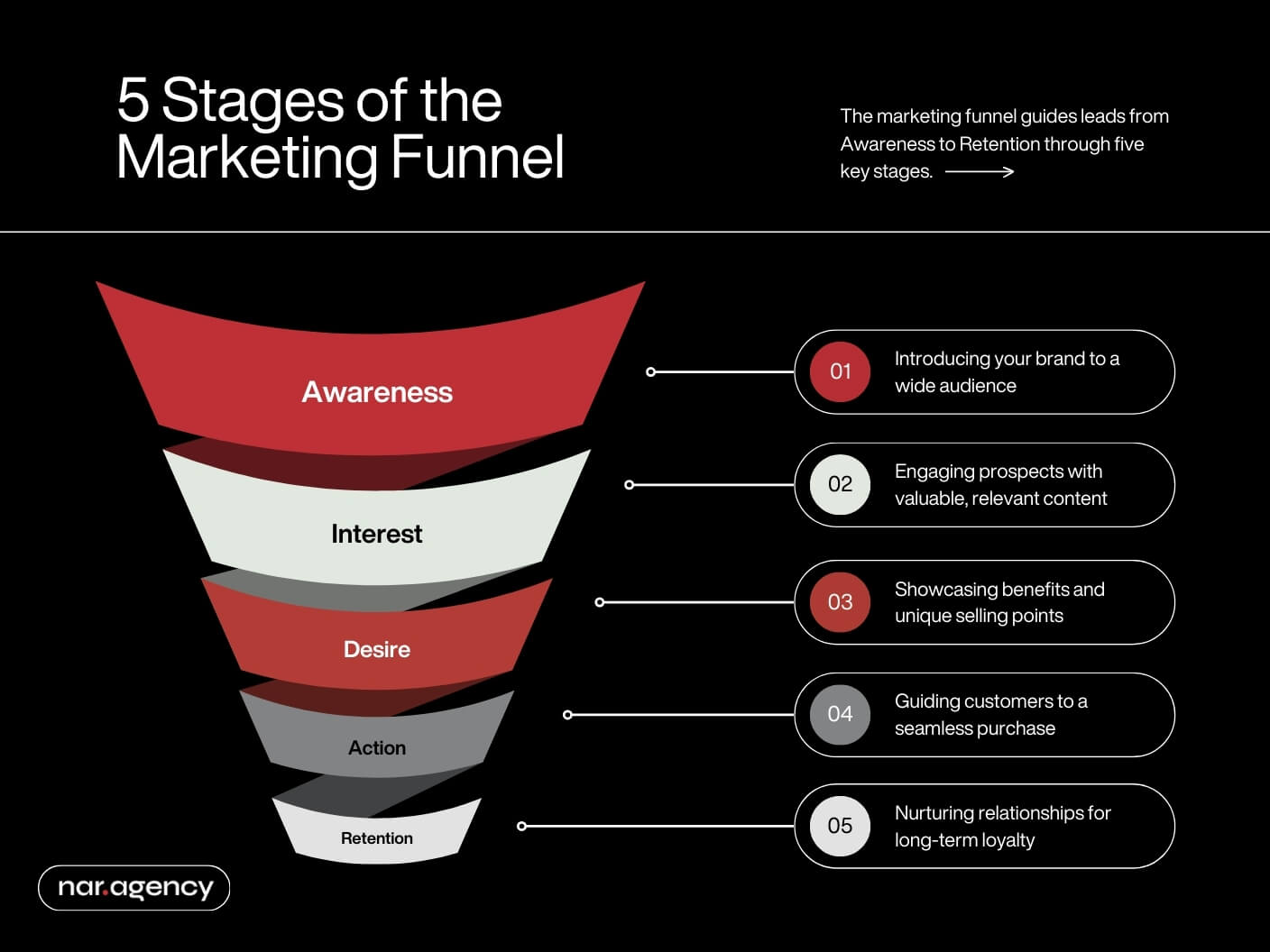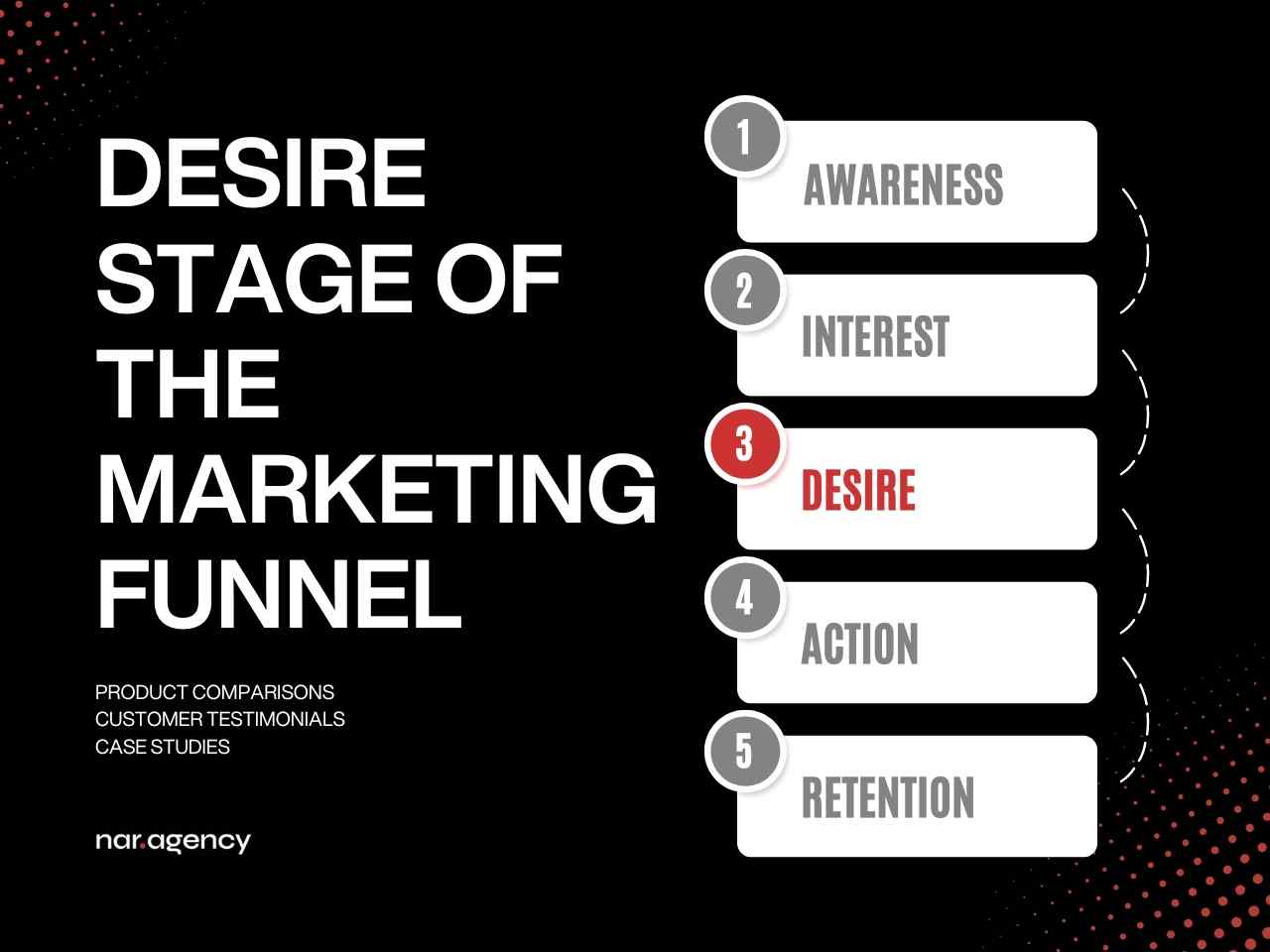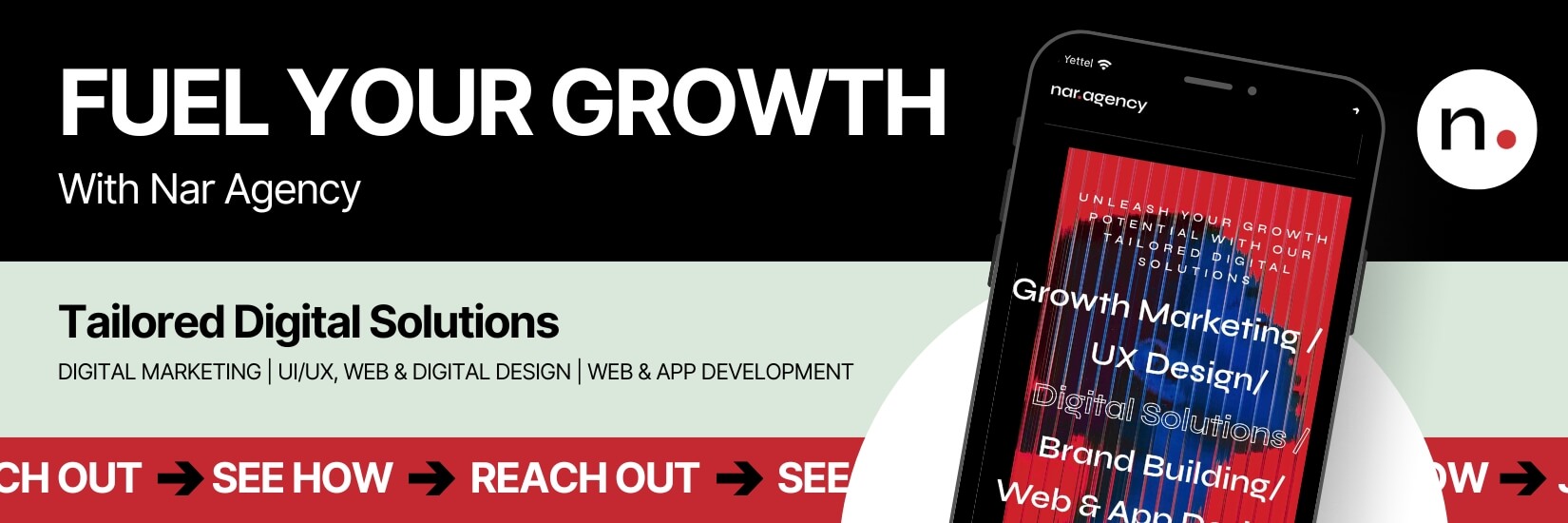Table of Contents
The marketing funnel is crucial for businesses to convert leads into loyal customers. According to Forrester Research, companies that excel at lead nurturing generate 50% more sales-ready leads at a 33% lower cost. The funnel represents a customer’s journey through five stages:
- Awareness
- Interest
- Desire
- Action
- Retention

Understanding each stage and the customer’s mindset allows marketers to create targeted strategies to increase conversion rates. As consumer behavior evolves and digital channels grow, businesses that effectively navigate the marketing funnel gain a significant advantage in capturing and converting leads. This article explores the five stages of the marketing funnel and provides insights on how to guide prospects through their decision-making process, ultimately transforming them into loyal customers.
Key Takeaways
- The 5 stages of the marketing funnel are Awareness, Interest, Desire, Action, and Retention, each playing a critical role in customer acquisition and loyalty
- Awareness involves casting a wide net to make potential customers aware of your brand through various channels such as social media, organic traffic, and press releases.
- Interest and Desire stages focus on nurturing leads by providing value, information, and engagement, moving towards developing a personalized connection with potential customers.
- The Action stage is where leads are converted into customers, requiring clear calls to action and streamlined processes that facilitate the purchasing decision.
- Retention is key to long-term success, emphasizing the importance of maintaining customer relationships and loyalty through continuous engagement and support.
1. Awareness Stage of the Marketing Funnel
The Awareness stage marks the beginning of a potential customer’s journey through the marketing funnel. It’s where curiosity is sparked and your brand has the chance to make a lasting first impression. The main objective is to broaden your reach and introduce your brand to a wide audience within your target market. This stage is about casting a wide net, rather than focusing on specifics, to ensure your message resonates broadly.
During this stage, it’s essential to generate interest and curiosity about your brand. Common tactics include content marketing, social media campaigns, and search engine optimization to create visibility. The aim is to draw in a broad audience with content that aligns with their interests or addresses their problems.
Boost your brand awareness with Nar Agency’s expert content marketing, social media management, and SEO services.
Airbnb's "Live There" Campaign
Airbnb launched a global campaign called "Live There" to raise awareness about their unique travel experiences. They used various channels including TV ads, social media, and influencer partnerships to showcase how staying in Airbnb properties allows travelers to live like locals rather than tourists.
Understanding the nuances of the Awareness stage and executing it with finesse is pivotal. It sets the tone for the effectiveness of subsequent efforts in the marketing funnel. This crucial first step demands careful planning, a deep understanding of your target audience, and a commitment to the value you offer to those embarking on their purchasing journey.
2. Interest Stage of the Funnel
Once initial awareness has been established, the marketing funnel progresses to the Interest stage. At this point, the focus shifts from broad brand exposure to cultivating a deeper connection with potential customers. The key is engagement; providing content that not only informs but also resonates with the specific needs and interests of the target audience.
The Interest stage is where brands have the opportunity to shape the perception of their offerings by highlighting unique features and benefits. The content delivered during this phase should aim to address the more nuanced questions and concerns that prospects may have, helping them move closer to a purchasing decision.
Effective strategies to engage prospects at the Interest stage include:
Targeted blog posts that delve into topics relevant to the audience’s pain points and interests
Educational webinars and video content that showcase the brand’s expertise and provide valuable insights
Interactive social media campaigns that encourage engagement and foster a sense of community
Personalized email marketing that nurtures the relationship by providing tailored content and offers
The goal is to provide value and build trust with potential customers, positioning the brand as a knowledgeable and reliable solution to their needs. By crafting engaging and purpose-driven content that aligns with the audience’s interests, brands can effectively guide prospects through the marketing funnel, increasing the likelihood of conversion and long-term loyalty.
Successful execution of the Interest stage requires a deep understanding of the target audience, a commitment to providing value, and a strategic approach to content creation and distribution. By focusing on these key elements, brands can effectively capture the attention of potential customers and guide them towards the next stage of the funnel.
HubSpot's Blog and Resources
HubSpot excels at the Interest stage by offering a wealth of free, valuable content through their blog, ebooks, and tools. They provide in-depth articles, guides, and templates on marketing, sales, and customer service topics, positioning themselves as a thought leader and attracting potential customers to explore their offerings further.
3. Desire Stage of the Marketing Funnel

As potential customers progress through the Marketing Funnel, they reach the Desire stage, where interest evolves into a deeper consideration of your offerings. This is where prospects start to envision your product or service as part of their solution, recognizing its value and how it stands out from the competition.
At this stage, your marketing efforts should focus on nurturing this budding interest into a strong desire. A strategic approach might include:
- Detailed product comparisons
- Customer testimonials
- Compelling case studies
Mailchimp's Free Trial and Case Studies
Mailchimp offers a free trial that allows potential customers to explore the platform's features. During the trial, they send a series of emails showcasing how Mailchimp solves specific pain points, backed by customer success stories and case studies demonstrating impressive results achieved by businesses using their platform.
By presenting clear differentiation and value, you can effectively convert interest into desire, paving the way for the next stage of the funnel. Successfully steering through the Desire stage involves a delicate balance of emotional and rational appeal.
Personalized offers, such as a free trial subscription or a time-sensitive discount, can be particularly effective when combined with persuasive narratives and case studies that highlight the impact of your product on users’ lives.
4. Action Stage of the Digital Marketing Funnel
At the Action stage of the digital marketing funnel, the journey of a prospect reaches its critical point. This is where the strategies developed in the earlier stages must converge to enable the transition from potential customer to actual buyer. The focus here is on conversion optimization, ensuring a seamless and frictionless purchase process.
The Action stage is pivotal, as it is where prospects are prompted to make a decisive move, such as making a purchase or signing up for a service.
To drive action effectively, consider the following points:
Optimize landing pages: Create focused landing pages that clearly communicate your value proposition and guide visitors towards action.
Simplify the conversion process: Remove any obstacles that could deter a prospect from completing the desired action, whether it’s a purchase, sign-up, or inquiry.
Enhance user experience: Ensure that the process of taking action is intuitive and user-friendly across all platforms and devices.
Use clear calls-to-action (CTAs): Implement strong, action-oriented language that clearly indicates the next step for the prospect.
Offer incentives: Provide compelling reasons for immediate action, such as limited-time offers, exclusive content, or special discounts.
Amazon's One-Click Ordering
Amazon's patented one-click ordering system is a prime example of optimizing the Action stage. By allowing customers to make purchases with a single click, Amazon removes friction from the buying process, significantly increasing conversion rates.
By meticulously removing barriers and streamlining the path to purchase, businesses can significantly increase their conversion rates and successfully transform interest and desire into definitive action.
5. Retention Stage of the Marketing Funnel
At the final stage of the marketing funnel, Retention is where businesses strive to keep their customers coming back. It’s not just about making a sale; it’s about nurturing a long-term relationship that turns first-time buyers into loyal brand advocates.
Customer retention is a critical metric, reflecting the percentage of customers who remain engaged over time. A high retention rate means you can focus more on enriching the customer experience rather than constantly seeking new leads.
Effective retention strategies involve personalized communication, exceptional customer service, and consistently delivering value. By doing so, companies foster a positive customer experience that encourages repeat business.
The essence of customer retention is understanding that a loyal customer base is not just beneficial but essential for sustainable growth and competitive advantage.
Understanding the different marketing channels for each stage of the funnel is crucial. Here’s a quick overview of channels that can be leveraged for retention:
- Email marketing for personalized offers
- Social media for community building
- Loyalty programs to reward repeat purchases
- Customer support for ongoing engagement
By mastering these channels, businesses can ensure that their marketing efforts resonate at every touchpoint, driving engagement and loyalty.
Starbucks Rewards Program
Starbucks' loyalty program is an excellent example of retention marketing. The program offers points (stars) for purchases, free refills, birthday rewards, and exclusive offers. This encourages repeat visits and increases customer lifetime value.
Measuring and Optimizing Your Digital Marketing Funnel
To ensure the effectiveness of your marketing funnel, it’s crucial to consistently measure performance and optimize based on data-driven insights. By tracking key performance indicators (KPIs) at each stage, you can identify bottlenecks, improve conversion rates, and maximize ROI.
Key Performance Indicators (KPIs) for Each Marketing Funnel Stage
1. Awareness
- Reach
- Impressions
- Website traffic
- Social media engagement
2. Interest
- Time on site
- Pages per session
- Email open rates
- Content downloads
3. Desire
- Click-through rates (CTR)
- Product page views
- Wishlist additions
- Cart abandonment rate
4. Action
- Conversion rate
- Average order value
- Cost per acquisition
- Revenue
5. Retention
- Customer Lifetime Value (CLV)
- Repeat purchase rate
- Churn rate
- Net Promoter Score (NPS)
START Your Growth
Optimize Your Marketing Funnel
At Nar Agency, we specialize in crafting tailored content for each stage of your marketing funnel. From awareness-building blog posts to conversion-focused landing pages, we’ve got you covered.



Don’t leave your funnel optimization to chance. Partner with Nar Agency and watch your leads transform into loyal customers.
Funnel Optimization Strategies
A/B Testing: Continuously test different elements of your funnel, such as landing pages, email subject lines, and CTAs, to identify what resonates best with your audience.
Personalization: Use data to tailor your messaging and offers to specific audience segments, improving relevance and engagement.
Funnel Visualization: Utilize tools like Google Analytics to create visual representations of your funnel, helping you identify where prospects are dropping off.
Customer Feedback: Regularly collect and analyze customer feedback to understand pain points and areas for improvement in your funnel.
Automation: Implement marketing automation tools to streamline processes and ensure timely, relevant communication with prospects at each stage.
By consistently measuring these KPIs and applying data-driven optimization strategies, you can refine your marketing funnel to more effectively guide prospects from awareness to loyalty, ultimately driving business growth and success
Types of Marketing Funnels: B2B vs. B2C Comparison
While the basic structure of the marketing funnel remains consistent, the approach and tactics can vary significantly between Business-to-Business (B2B) and Business-to-Consumer (B2C) models. Let’s compare the key aspects of B2B and B2C marketing funnels:
| Aspect | B2B Marketing Funnel | B2C Marketing Funnel |
|---|---|---|
| Funnel Length | Typically longer | Usually shorter |
| Decision-Making Process | Complex, often involving multiple stakeholders | Simpler, often individual-based |
| Awareness Stage | Focus on industry-specific channels, trade shows, LinkedIn | Broader reach through social media, TV, print ads |
| Interest Stage | Emphasis on detailed whitepapers, case studies, webinars | Product reviews, influencer marketing, social proof |
| Desire Stage | Product demos, free trials, ROI calculators | Special offers, limited-time deals, product comparisons |
| Action Stage | Often involves negotiations, customized proposals | Quick checkout process, one-click purchasing |
| Retention Stage | Account management, ongoing support, upselling | Loyalty programs, personalized recommendations |
| Average Sales Cycle | Weeks to months | Hours to days |
| Content Type | In-depth, technical, educational | Emotional, lifestyle-focused, concise |
| Key Metrics | Lead quality, Sales Qualified Leads (SQL) | Conversion rate, Average Order Value (AOV) |
| Customer Lifetime Value | Generally higher | Usually lower, but with higher volume |
| Primary Marketing Channels | LinkedIn, industry publications, direct sales | Social media, email, e-commerce platforms |
As this comparison illustrates, B2B and B2C funnels differ significantly in various aspects. B2B funnels typically involve longer, more complex decision-making processes with multiple touchpoints, while B2C funnels are often shorter and more straightforward.
Understanding these differences allows you to tailor your strategies, content, and channels to effectively guide prospects through the appropriate funnel, ultimately leading to higher conversion rates and customer satisfaction.
Conclusion
In conclusion, the 5 stages of the marketing funnel—Awareness, Interest, Desire, Action, and Retention—serve as a strategic blueprint for capturing and converting leads into loyal customers. By understanding and implementing tailored strategies at each stage, businesses can effectively guide potential customers through the funnel, nurturing their journey from initial awareness to final purchase and beyond. It’s crucial for marketers to continuously analyze and refine their approach, adapting to the unique demands of their target audience and the evolving digital landscape. With a well-constructed marketing funnel, companies can not only improve conversion rates but also foster lasting relationships that contribute to sustained business growth and success.
Frequently Asked Questions
A marketing funnel is a conceptual model that illustrates the journey a customer takes from first becoming aware of a brand to making a purchase and potentially becoming a repeat customer. It typically consists of stages such as Awareness, Interest, Desire, Action, and Retention, each representing a different phase of the customer's decision-making process.
The 5 stages of the marketing funnel are Awareness, Interest, Desire, Action, and Retention. These stages represent the customer's journey from first learning about a brand to becoming a loyal customer.
To create an effective marketing funnel:
Define your target audience
Create content for each stage of the funnel
Choose appropriate marketing channels for each stage
Implement lead capture mechanisms
Develop nurturing strategies for moving leads through the funnel
Set up conversion tracking and analytics
Continuously test and optimize your funnel based on data and feedback
Understanding the marketing funnel is crucial for businesses because it helps them tailor their marketing strategies to effectively guide potential customers through each stage, from initial awareness to final purchase and beyond, enhancing the chances of conversion and customer loyalty.
In the Awareness stage, potential customers first encounter your brand. Strategies at this stage focus on broad reach to foster brand recognition through channels like social media, content marketing, and advertising.
The Interest stage deepens the potential customer's engagement with your brand. It's about providing value, information, and engagement to build trust and move leads further down the funnel.
The Desire stage aims to cultivate a strong inclination in potential customers to choose your product or service over competitors. This involves highlighting unique selling points and benefits to create an emotional connection.
The Action stage is where the lead makes a purchase decision. Here, the focus is on creating a seamless buying experience, offering incentives, and providing reassurance through guarantees or customer testimonials.
The Retention stage is critical because it's about turning one-time buyers into repeat customers. This involves post-purchase engagement, customer support, loyalty programs, and seeking customer feedback for continuous improvement.
Share :
Read More
10 Growth Marketing Strategies for Scaling Your Business in 2025
Discover 10 cutting-edge growth marketing strategies to scale your business in 2025. From leveraging AI and programmatic SEO to harnessing the power of podcasts and community-led tactics, learn how top companies are driving transformational growth. This guide explores proven methods for sustainable traffic growth, maximizing brand visibility, personalizing user experiences, and overcoming key B2B SaaS challenges. Unlock the secrets to balancing performance marketing with brand building and creating scalable growth through strategic content and sales assets.
How to Choose the Right Product Design Agency for Your Project
Choosing the right product design agency is crucial for your project’s success. This guide explores key factors to consider, including agency experience, portfolio quality, design process, collaboration skills, and technical expertise. Learn how to evaluate costs, check references, and make an informed decision to find the perfect partner for bringing your digital product vision to life. Discover the essential steps to selecting a product design agency that aligns with your goals and delivers innovative solutions.
Digital Product Design Trends for 2025
Discover the cutting-edge digital product design trends shaping 2025. From hyper-realistic 3D and AR to biophilic elements and AI-generated designs, explore how these innovations will transform user experiences and redefine digital interactions.




